Real estate boom continues in Oman

The Sultanate of Oman is in the midst of a property boom. The capital, Muscat, and the coastal cities of Salalah, Sohar and Sur have undergone the highest house price increases.
Land prices have gone up tenfold in the last three years in some areas of the sultanate, real estate analysts claim. Residential land prices in Oman soared by about 400% to OMR81 (US$210) per sq. m. in the two years to June 2008, from OMR16.3 (US$42) per sq. m. in 2006, according to Al Mazaya Holding Co., a real estate shareholding company.
In the Wave, Muscat’s first freehold tourism and residential development, the price of a three-bedroom villa (302-410 sq. m.) ranges from OMR149,500 (US$338,352) to OMR270,175 (US$701,826). A four-bedroom villa (365-491 sq. m.) costs around OMR187,695 (US$487,570) to OMR338,745 (US$879,948).
At the Blue City, the biggest real estate development, located in the coastal region of Al Sawadi, residential units sell at a premium. A one-bedroom apartment costs around OMR114,200 (US$296,654), while a two-bedroom house sells for OMR190,600 (US$495,116).
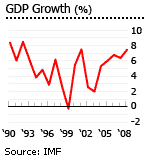
Higher oil revenues have been the main drivers of Oman’s strong economy. Omanis’ rising purchasing power has fuelled growing demand for residential units. Foreign investment, the liberalization of the real property laws and healthy tourism have added to Oman’s real estate boom. On the supply side, soaring construction costs and land prices have added to price increases.
Real estate liberalisation
In December 2002, GCC nationals won the right to own real estate in Oman for the purpose of residence or investment, through an accord on cross-border real estate ownership.
In February 2006, all other nationalities were given the right to own real properties, but only in Integrated Tourism Complexes (ITCs). Expatriate property owners automatically get residency rights for themselves and their immediate families, by virtue of the property acquisition.
The opening of Oman’s real estate market is part of Oman’s “Vision 2020” development plan. This aims to diversify Oman’s economy, and reduce oil’s contribution on to GDP to 9% by 2020.
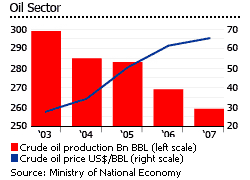
Since 2003 oil production has been shrinking. In 2007 alone, crude oil production fell 13.4%. Some see oil running out around 2022. However, surging petroleum prices mean that oil revenues still play a very important role in Oman’s economy.
Oman’s diversification plan has generated rapid growth in its non-oil sectors, especially tourism, manufacturing and construction. Tourism registered 9% growth in 2007, and 19% growth in 2006. In 2008, a healthy 7% growth in tourism revenues is projected.
Housing finance and interest rate
Over the past three years Omani banks have been given much more freedom to make housing loans.
More Global Property Guide pages: |
Before 2006, only two banks were allowed to make housing loans – the government-owned Oman Housing Bank, and the private-owned Alliance Housing Bank. Then in 2006, commercial banks were permitted to offer housing mortgages up to a lending cap of 5% of the bank’s total loan portfolio. Then in June 2008, the Central Bank of Oman (CBO) raised the housing lending cap from 5% to 10% of the loan portfolio.
Omani banks then started to offer housing loans to expatriates and foreign nationals. Typically, the maximum mortgage amount is 80% of the property value, payable over 20 years.
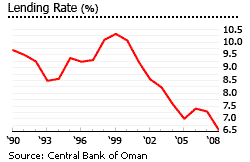
Personal loans, a category which includes mortgages, have steadily been rising since 2001. In 2007, personal loans grew 42.5% y-o-y to OMR2.6 (US$6.75) billion.
The CBO has also lowered the interest ceiling on personal loans from 8.5% to 8%. The central bank’s previous cut on personal loan rates came in March, when it reduced the ceiling by 50 basis points.
Rising housing demand
Oman’s growing population means that housing demand is outstripping supply. In 2007, the total population of Oman was estimated to be 2.74 million, growing at an annual average rate of 2%.
Oman’s population is predominantly young. More than half of native Omanis are under the age of 20. In 2008, the median age is estimated at 18.9. Native Omanis comprise 70% of the population, while the remaining 30% are expatriates.
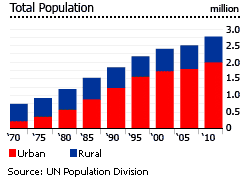
The growing number of expat workers in Oman is fuelling the real estate boom. In 2007, the expat population grew 4.1% to 820,000, according to the Ministry of National Economy. Analysts predict that Oman’s real estate market will continue to grow. The value of real estate demand will top OMR8 (US$20.8) billion by 2010, according to property consultants of Eqarat.com, a Dubai-based real estate solution provider.
Inflation and housing rents
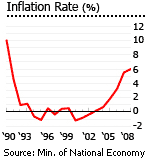
Rents have been skyrocketing in recent years, especially in Muscat and other high-demand coastal areas. In June 2008, inflation climbed to 13.7%, an 18-year high. Similar to other countries in the Gulf, Oman’s inflation has been driven by rising food prices and by rising rents.
Housing rents in Muscat have more than doubled over the past year. In Ruwi, Muscat’s business district, monthly rents for one-bedroom apartments are now around OMR250 (US$650) to OMR300 (US$780), up from only OMR100 (US$260) a year earlier.
In Azaiba, Muscat’s coastal village, two-bedroom apartments rent for OMR500 (US$1,300) to OMR600 (US$1,560) per month; up from OMR250 (US$650) to OMR300 (US$780) a year earlier.

In June 2008 new rental regulations were introduced to protect tenant rights, because of the housing rents surge. Landlords may now only increase the rent every 3 years, and by a maximum of 7% of the annual rent value stipulated in the lease contract.
The law also bars landlords from evicting tenants before the agreed lease period. A minimum lease period of 4 years for residential property and 7 years for commercial property was imposed.
Housing supply
In 2003, the total housing stock in Oman was 430,996 housing units, of which 368,044 were traditional housing units, according to the General Census for Population and Housing.
Arabic houses comprised 39.7% of the total housing stock; villas, 23.6%; apartments, 17.3%; rural houses, 4.8%; improvised housing units, 13.6%; and institutional housing units, 1%.
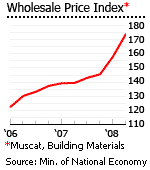
From 2001 to 2005, the Ministry of Housing, Electricity and Water allocated OMR6.5 (US$16.9) million for the construction and maintenance of 1,032 housing units in Oman. In 2006, a total of OMR38 (US$98.7) million budget was allocated to social housing to fund the construction of 1,399 housing units.
In 2007, total investments into the real estate market was OMR1.61 (US$4.2) billion, up from only OMR0.29 (US$0.75) million in 2005.
Integrated Tourism Complexes
Since Oman’s market opening, investments into the real estate market have been skyrocketing. The two megacity projects—The Wave and the Blue City—are only among the numerous Integrated Tourism Complexes, where foreigners can buy properties.
Due to numerous construction projects in the GCC countries, the prices of steel, iron, cement and other building materials are rapidly rising in Oman. In Q2 2008, Muscat’s wholesale price index for building materials rose 25% y-o-y.
The Wave, built along a strip of a beach in Muscat, is the first Integrated Tourism Complex where non-GCC nationals are allowed to buy real properties. Construction commenced in 2006. This mega-project is worth OMR805 million (US$2 billion). It covers an area of 2.5 million sq. m. which includes more than 4,000 residential units.
Blue City is located in Al Sawadi, west of Muscat. This OMR7.7 (US$20) billion project, which has an area of 34 sq. km., is projected to house a total of 250,000 residents. Phase1 of the Blue City, which is worth OMR0.85 (US$2.2) billion, will include 200 villas and 5,000 apartments. Construction of Phase 1 began in late 2006 and is due for completion in 2011.

Salam Yiti is a 4.19 sq. km. luxurious residential resort located in between the Al Hajar Ash Sharqi Mountains and the Gulf of Oman, south of Muscat. This OMR0.65 (US$1.7) billion project includes a residential area with 720 townhouses, more than 400 villas and 1,000 apartments.
The Muriya Tourism Development, which costs OMR231 (US$600) million involves the development of beachside communities at Salalah, Jebel Sifah, Wadi Al Qurum, and Al Soda Island. The first phase of Salalah beach and Jebel Sifah has been sold out in its launching in November 2007.
The Jebel Sifah project, which is 45km from Muscat, is set on a 6.2 million sq. m. site with 5km of beachfront. It will offer more than 1,000 residential units and 2,000 hotel rooms.
Salalah Beach, located southeast of Muscat on the coast of Arabian Sea, has an area of 15.6 million sq. m. The development will offer 1,200 residential units and 1,200 hotel rooms when finished.